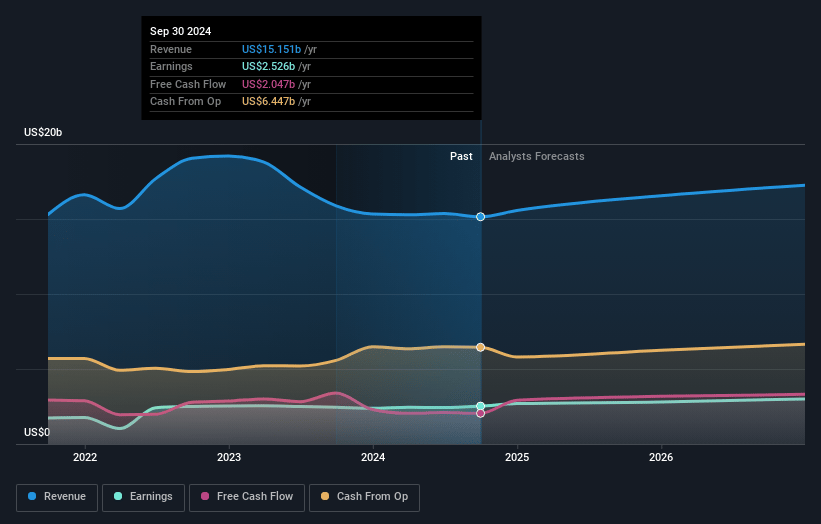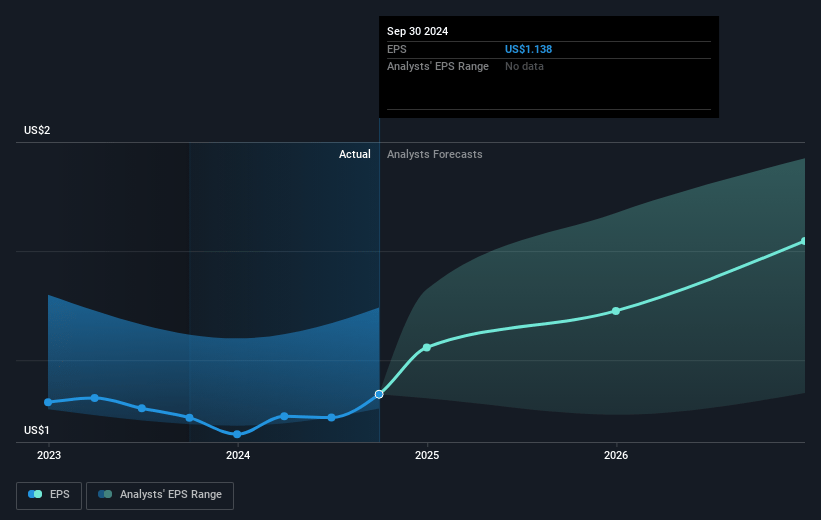Narratives are currently in beta
Key Takeaways
- Expansion projects and strong demand in natural gas are expected to significantly boost Kinder Morgan's capacity, revenue, and earnings.
- Strategic asset utilization and contract renewals aim to enhance margins, sustaining earnings growth.
- Lower commodity prices, regulatory risks, and project delays threaten Kinder Morgan's revenue growth, earnings, and economic returns.
Catalysts
About Kinder Morgan- Operates as an energy infrastructure company primarily in North America.
- Kinder Morgan expects strong growth in natural gas demand driven by LNG exports and industrial needs, supporting future revenue increases through infrastructure expansion and new projects.
- The $3 billion South System expansion and GCX system expansion, backed by long-term commitments, are expected to boost capacity and directly enhance revenue and earnings.
- Continued project backlog growth, now totaling $5.1 billion, indicates robust future development activities that could significantly contribute to EBITDA and earnings growth.
- Opportunities in power, industrial, and export markets, combined with potential projects to expand pipeline capacity, suggest positive future revenue and net margin impacts.
- Strategic asset utilization and contract renewals, particularly on storage facilities and Jones Act tankers, are positioned to enhance margins and improve earnings sustainability.
Kinder Morgan Future Earnings and Revenue Growth
Assumptions
How have these above catalysts been quantified?- Analysts are assuming Kinder Morgan's revenue will grow by 7.7% annually over the next 3 years.
- Analysts assume that profit margins will increase from 16.7% today to 18.1% in 3 years time.
- Analysts expect earnings to reach $3.4 billion (and earnings per share of $1.55) by about November 2027, up from $2.5 billion today. However, there is some disagreement amongst the analysts with the more bearish ones expecting earnings as low as $2.5 billion.
- In order for the above numbers to justify the analysts price target, the company would need to trade at a PE ratio of 20.3x on those 2027 earnings, down from 23.6x today. This future PE is greater than the current PE for the US Oil and Gas industry at 11.0x.
- Analysts expect the number of shares outstanding to decline by 0.16% per year for the next 3 years.
- To value all of this in today's terms, we will use a discount rate of 8.17%, as per the Simply Wall St company report.
Kinder Morgan Future Earnings Per Share Growth
Risks
What could happen that would invalidate this narrative?- The company faces potential challenges from lower commodity prices and slower startup of its renewable natural gas (RNG) facilities, which could impact its revenue and earnings projections.
- Projects in the company's backlog, including large ones, may not come to fruition or could face delays, affecting the expected growth in earnings per share (EPS) and economic returns.
- The company has litigation risk relating to regulatory approvals, such as the Cumberland project, which if delayed or canceled, could affect future revenue and profitability.
- There is uncertainty regarding natural gas gathering volumes, which are expected to average 8% below the 2024 plan, potentially affecting the company's revenue growth this year.
- Economic conditions impacting key businesses, such as products and terminals, driven by fluctuating refined product volumes and commodity price risks, could affect net margins and earnings.
Valuation
How have all the factors above been brought together to estimate a fair value?- The analysts have a consensus price target of $24.84 for Kinder Morgan based on their expectations of its future earnings growth, profit margins and other risk factors. However, there is a degree of disagreement amongst analysts, with the most bullish reporting a price target of $29.0, and the most bearish reporting a price target of just $22.0.
- In order for you to agree with the analyst's consensus, you'd need to believe that by 2027, revenues will be $18.9 billion, earnings will come to $3.4 billion, and it would be trading on a PE ratio of 20.3x, assuming you use a discount rate of 8.2%.
- Given the current share price of $26.8, the analyst's price target of $24.84 is 7.9% lower. The relatively low difference between the current share price and the analyst consensus price target indicates that they believe on average, the company is fairly priced.
- We always encourage you to reach your own conclusions though. So sense check these analyst numbers against your own assumptions and expectations based on your understanding of the business and what you believe is probable.
How well do narratives help inform your perspective?
Disclaimer
Warren A.I. is a tool utilizing a Large Language Model (LLM) that ingests data on consensus price targets, forecasted revenue and earnings figures, as well as the transcripts of earnings calls to produce qualitative analysis. The narratives produced by Warren A.I. are general in nature and are based solely on analyst data and publicly-available material published by the respective companies. These scenarios are not indicative of the company's future performance and are exploratory in nature. Simply Wall St has no position in the company(s) mentioned. The price targets and estimates used are consensus data, and do not constitute a recommendation to buy or sell any stock, and they do not take account of your objectives, or your financial situation. Note that Warren A.I.'s analysis may not factor in the latest price-sensitive company announcements or qualitative material.
Read more narratives
There are no other narratives for this company.
View all narratives



